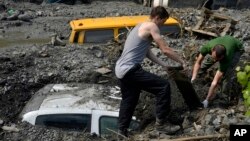In mid-May, an unusual low-pressure weather system brought torrential rain to south-Eastern Europe, particularly the Balkans, causing some 2,000 landslides and killing at least 77 people. Serbia and Bosnia-Herzegovina suffered the greatest damage. The floods affected at least 1.6 million in Serbia and Bosnia alone.
The United States wishes to express its sincerest condolences to all those in Bosnia and Herzegovina, Serbia, and Croatia who have suffered as a result of the devastating flooding. The United States is already providing assistance, and will continue to look for ways to assist in the recovery process.
Dozens of countries have sent aid, and it will take a concerted effort to help the flooded regions get back on their feet. The United States has already delivered 26 boats for search and rescue operations and over 25 tons of immediate aid, including water purification units, generators and fuel, kitchens, sleeping bags, blankets and cots, along with wet weather gear and clothing. The American Embassies in both Bosnia-Herzegovina and Serbia have also established processes that will release additional funds for aid.
But the U.S. is also delivering help to deal with another kind of danger: landmines left over from the Balkan Civil War in the early 1990s. Some 120,000 landmines remain from the 1992-1995 conflict. As flood waters rushed across the landscape, they carried off soil, collapsed riverbanks and caused landslides. In the process, the floods also carried away signs marking minefields, and uncovered and moved pieces of unexploded ordnance. At least one landmine dislodged by the floods exploded underwater near the town of Brcko in Bosnia-Herzegovina, but caused no damage or casualties.
On May 25th, following a request from the Serbia and Bosnia-Herzegovina Mine Action Centers, the Department of State’s Office of Weapons Removal and Abatement deployed two separate teams, each consisting of three civilian explosive ordnance disposal experts. These two teams are assisting local authorities in assessing the landmine situation following the floods. The teams are identifying assistance gaps and providing recommendations to U.S. and local authorities on future demining program requirements.
The Government of Bosnia and Herzegovina estimates that 320 square kilometers of the flood zones are potentially contaminated by shifting mines. Similar problems have been reported in Serbia.
The United States stands ready to provide each of the countries affected by the flooding with further assistance, and will assist as they begin to recover and rebuild.
The United States wishes to express its sincerest condolences to all those in Bosnia and Herzegovina, Serbia, and Croatia who have suffered as a result of the devastating flooding. The United States is already providing assistance, and will continue to look for ways to assist in the recovery process.
Dozens of countries have sent aid, and it will take a concerted effort to help the flooded regions get back on their feet. The United States has already delivered 26 boats for search and rescue operations and over 25 tons of immediate aid, including water purification units, generators and fuel, kitchens, sleeping bags, blankets and cots, along with wet weather gear and clothing. The American Embassies in both Bosnia-Herzegovina and Serbia have also established processes that will release additional funds for aid.
But the U.S. is also delivering help to deal with another kind of danger: landmines left over from the Balkan Civil War in the early 1990s. Some 120,000 landmines remain from the 1992-1995 conflict. As flood waters rushed across the landscape, they carried off soil, collapsed riverbanks and caused landslides. In the process, the floods also carried away signs marking minefields, and uncovered and moved pieces of unexploded ordnance. At least one landmine dislodged by the floods exploded underwater near the town of Brcko in Bosnia-Herzegovina, but caused no damage or casualties.
On May 25th, following a request from the Serbia and Bosnia-Herzegovina Mine Action Centers, the Department of State’s Office of Weapons Removal and Abatement deployed two separate teams, each consisting of three civilian explosive ordnance disposal experts. These two teams are assisting local authorities in assessing the landmine situation following the floods. The teams are identifying assistance gaps and providing recommendations to U.S. and local authorities on future demining program requirements.
The Government of Bosnia and Herzegovina estimates that 320 square kilometers of the flood zones are potentially contaminated by shifting mines. Similar problems have been reported in Serbia.
The United States stands ready to provide each of the countries affected by the flooding with further assistance, and will assist as they begin to recover and rebuild.












